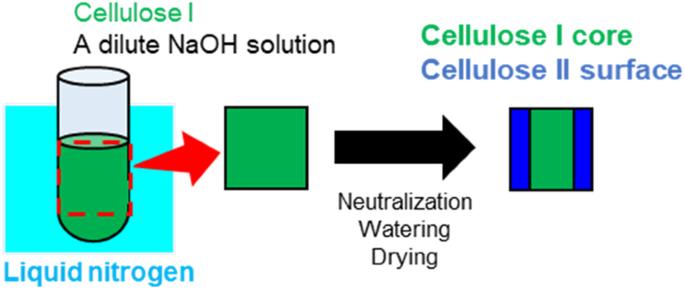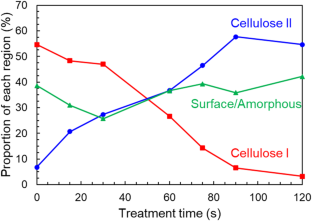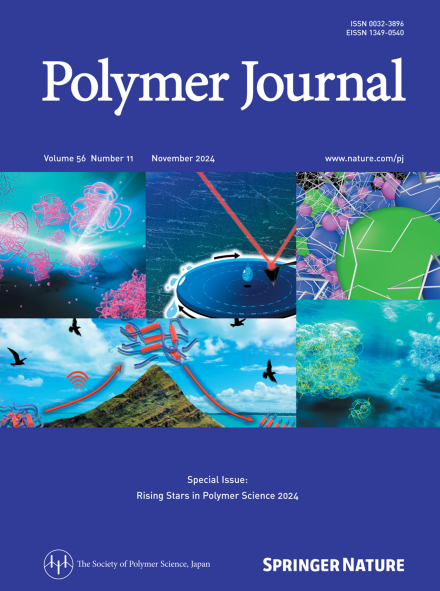优化低温、低浓度 NaOH 溶液中的晶体转变,制备纤维素 I 和 II 复合材料
IF 2.7
4区 化学
Q3 POLYMER SCIENCE
引用次数: 0
摘要
纤维素 II 具有优异的特性,包括柔韧性、高染色性和光泽度。然而,由于在晶体转变过程中结晶度降低,其强度低于纤维素 I。在这项研究中,我们设计了一种新方法来调节纤维素 I 和纤维素 II 晶体的比例和分布。通过使用低浓度的碱性溶液和液氮,我们得到了一种高强度的复合材料,同时保留了纤维素 II 的优良特性。将纤维素粉末浸入 8 wt% 的 NaOH 溶液中并用液氮淬火后,纤维素 I 向纤维素 II 的晶体转变从样品外围向中心延伸。纤维素 II 的比例随着处理时间的延长而成正比增加。这项技术被推广到富含纤维素 I 的棉纤维上,从而制造出一种核心为纤维素 I、表面为纤维素 II 的复合纤维。复合纤维的拉伸强度和杨氏模量均大于丝光处理后的纤维素 II 纤维。此外,这些纤维的断裂伸长率和韧性也超过了传统棉纤维。这种创新方法可制备出具有不同性能的纤维素 I 和 II 复合材料。这项研究开发了一种控制纤维素 I 和 II 的纤维素晶体的新方法。将浸泡在低浓度 NaOH 水溶液中的纤维素 I 用液氮淬灭后,跟踪了从纤维素 I 到纤维素 II 的晶体转变。晶体转变从样品表面向中心发展。这种淬火处理方法有望制造出具有纤维素 I 核心和纤维素 II 表面的新型纤维素材料。本文章由计算机程序翻译,如有差异,请以英文原文为准。


Optimizing crystal transitions in low-temperature, low-concentration NaOH solutions to prepare cellulose I and II composite materials
Cellulose II exhibits exceptional attributes, including flexibility, high stainability, and gloss. However, its strength is lower than that of cellulose I due to reduced crystallinity during the crystal transition. In this study, we devised a novel method to regulate the proportion and distribution of cellulose I and II crystals. This was achieved by employing a low-concentration alkaline solution and liquid nitrogen, resulting in a high-strength composite material that retained the excellent properties of cellulose II. When cellulose powder was immersed in an 8 wt% NaOH solution and quenched with liquid nitrogen, the crystal transition from cellulose I to II occurred outward from the sample periphery to its center. The percentage of cellulose II increased proportionally with treatment time. This technique was extended to cellulose I-rich cotton fibers, facilitating the creation of a composite fiber with cellulose I at the core and cellulose II on the surface. The tensile strength and Young’s modulus of the composite fiber were greater than those of the mercerized cellulose II fiber. Additionally, the elongation at break and toughness of these fibers surpassed those of conventional cotton fibers. This innovative method allows for the preparation of cellulose I and II composite materials with diverse properties. This study developed a novel method for the control of the cellulose crystal of cellulose I and II. The crystal transition from cellulose I to II was tracked when cellulose I, which is soaked in a low-concentration NaOH aqueous solution, was quenched using liquid nitrogen. The crystal transition progressed from the surface to the center of the sample. This quench treatment has the potential to fabricate new cellulose materials with a cellulose I core and a cellulose II surface.
求助全文
通过发布文献求助,成功后即可免费获取论文全文。
去求助
来源期刊

Polymer Journal
化学-高分子科学
CiteScore
5.60
自引率
7.10%
发文量
131
审稿时长
2.5 months
期刊介绍:
Polymer Journal promotes research from all aspects of polymer science from anywhere in the world and aims to provide an integrated platform for scientific communication that assists the advancement of polymer science and related fields. The journal publishes Original Articles, Notes, Short Communications and Reviews.
Subject areas and topics of particular interest within the journal''s scope include, but are not limited to, those listed below:
Polymer synthesis and reactions
Polymer structures
Physical properties of polymers
Polymer surface and interfaces
Functional polymers
Supramolecular polymers
Self-assembled materials
Biopolymers and bio-related polymer materials
Polymer engineering.
 求助内容:
求助内容: 应助结果提醒方式:
应助结果提醒方式:


